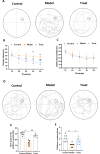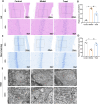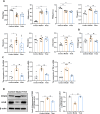PCSK9 inhibitor effectively alleviated cognitive dysfunction in a type 2 diabetes mellitus rat model
- PMID: 39157774
- PMCID: PMC11330219
- DOI: 10.7717/peerj.17676
PCSK9 inhibitor effectively alleviated cognitive dysfunction in a type 2 diabetes mellitus rat model
Abstract
Background: The incidence of diabetes-associated cognitive dysfunction (DACD) is increasing; however, few clinical intervention measures are available for the prevention and treatment of this disease. Research has shown that proprotein convertase subtilisin/kexin type 9 (PCSK9) inhibitors, particularly SBC-115076, have a protective effect against various neurodegenerative diseases. However, their role in DACD remains unknown. In this study, we aimed to explore the impact of PCSK9 inhibitors on DACD.
Methods: Male Sprague-Dawley (SD) rats were used to establish an animal model of type 2 diabetes mellitus (T2DM). The rats were randomly divided into three groups: the Control group (Control, healthy rats, n = 8), the Model group (Model, rats with T2DM, n = 8), and the PCSK9 inhibitor-treated group (Treat, T2DM rats treated with PCSK9 inhibitors, n = 8). To assess the spatial learning and memory of the rats in each group, the Morris water maze (MWM) test was conducted. Hematoxylin-eosin staining and Nissl staining procedures were performed to assess the structural characteristics and functional status of the neurons of rats from each group. Transmission electron microscopy was used to examine the morphology and structure of the hippocampal neurons. Determine serum PCSK9 and lipid metabolism indicators in each group of rats. Use qRT-PCR to detect the expression levels of interleukin (IL)-1β, IL-6, and tumor necrosis factor-alpha (TNF-α) in the hippocampal tissues of each group of rats. Western blot was used to detect the expression of PCSK9 and low-density lipoprotein receptor (LDLR) in the hippocampal tissues of rats. In addition, a 4D label-free quantitative proteomics approach was used to analyse protein expression in rat hippocampal tissues. The expression of selected proteins in hippocampal tissues was verified by parallel reaction monitoring (PRM) and immunohistochemistry (IHC).
Results: The results showed that the PCSK9 inhibitor alleviated cognitive dysfunction in T2DM rats. PCSK9 inhibitors can reduce PCSK9, total cholesterol (TC), and low-density lipoprotein (LDL) levels in the serum of T2DM rats. Meanwhile, it was found that PCSK9 inhibitors can reduce the expression of PCSK9, IL-1β, IL-6, and TNF-α in the hippocampal tissues of T2DM rats, while increasing the expression of LDLR. Thirteen potential target proteins for the action of PCSK9 inhibitors on DACD rats were identified. PRM and IHC revealed that PCSK9 inhibitors effectively counteracted the downregulation of transthyretin in DACD rats.
Conclusion: This study uncovered the target proteins and specific mechanisms of PCSK9 inhibitors in DACD, providing an experimental basis for the clinical application of PCSK9 inhibitors for the potential treatment of DACD.
Keywords: Diabetes-associated cognitive dysfunction; PCSK9 inhibitors; Parallel reaction monitoring; Proteomics.
© 2024 Yang et al.
Conflict of interest statement
The authors declare that they have no competing interests.
Figures








References
-
- Apaijai N, Moisescu DM, Palee S, McSweeney CM, Saiyasit N, Maneechote C, Boonnag C, Chattipakorn N, Chattipakorn SC. Pretreatment with PCSK9 inhibitor protects the brain against cardiac Ischemia/Reperfusion injury through a reduction of neuronal inflammation and amyloid beta aggregation. Journal of the American Heart Association. 2019;8(2):e010838. doi: 10.1161/JAHA.118.010838. - DOI - PMC - PubMed
-
- Arunsak B, Pratchayasakul W, Amput P, Chattipakorn K, Tosukhowong T, Kerdphoo S, Jaiwongkum T, Thonusin C, Palee S, Chattipakorn N, Chattipakorn SC. Proprotein convertase subtilisin/kexin type 9 (PCSK9) inhibitor exerts greater efficacy than atorvastatin on improvement of brain function and cognition in obese rats. Archives of Biochemistry and Biophysics. 2020;689(8):108470. doi: 10.1016/j.abb.2020.108470. - DOI - PubMed
MeSH terms
Substances
LinkOut - more resources
Full Text Sources
Medical
Research Materials
Miscellaneous

